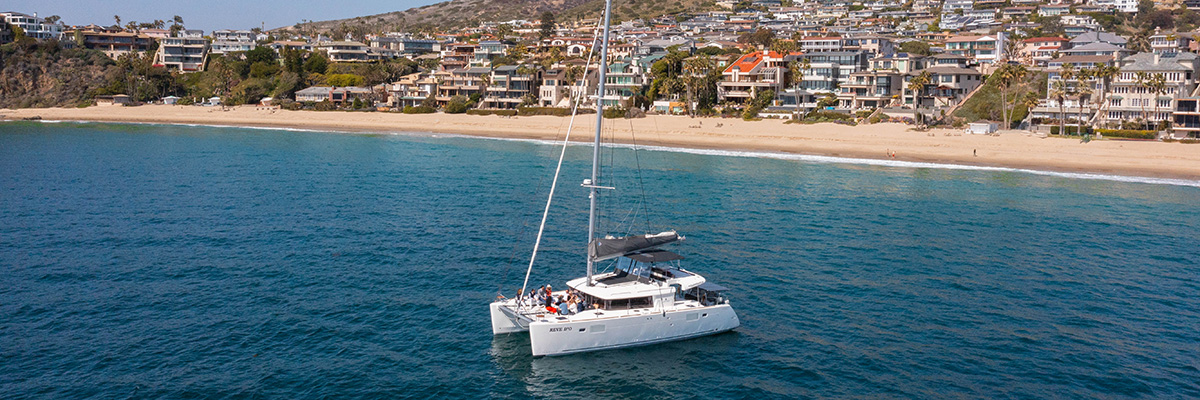ASA 114 – Cruising Catamaran
ASA 114, Cruising Catamaran Course,
This is a 6-hour course on a Lagoon 400 or 450 Catamaran
Group Course: $695 per person. Total of three students–You and three other students, who we match you up with. Please click here to choose your course dates. Please click here to choose your course dates.
Private Course 1 Student: $1810 total. A private course just for you, based on your schedule. Click here to tell us when you would like to start.
Private Course 2 Students: $1910 total. A private course for you and someone you know, based on your schedule. Click here to tell us when you would like to start.
Private Course 3 Students: $2010 total. A private course for you and two people who you know, based on your schedule. Click here to tell us when you would like to start.
Private Course 4 Students: $2110 total. A private course for you and three people who you know, based on your schedule. Click here to tell us when you would like to start.
Information about the Course
114 Overview
In this course, you will learn to skipper an auxiliary-powered sailing catamaran upon coastal waters in moderate to heavy winds (up to 20 knots) and sea conditions. Learn catamaran structure, components and features, performance under sail and power, boat systems, seamanship and safety, heavy weather operation, and emergency response.
For a full list of all 57 topics (knowledge and skills) plus knots that will be covered click below.
Catamaran Terminology
1. Identify and describe the functions of the following terms and structural components:
- Catamaran
- Hull
- Nacelle
- Full Bridgedeck
- Partial Bridgedeck
- Deckhouse
- Crossbeams
- Fixed keel
- Daggerboard
- Escape hatch
- Trampoline
- Bridle
- Twin engine
- Mainsail Roach
- Dolphin Striker
- Seagull Striker
2. Identify and describe the functions of the following rigging terms and components:
- Fractional rig
- Tripod rig
- Diamond stays
- Spreaders
- Shrouds
- Forestay
Catamaran Features & Performance
3. Describe the accommodations of a typical catamaran and their effect on comfort and safety.
4. Compare differences in operating and living aboard a monohull and catamaran of similar length.
5. Describe the impact that a catamaran’s deck structures may have on visibility from the helm.
6. Describe stability differences between a ballasted monohull keelboat and a catamaran.
7. Describe load-carrying characteristics of a catamaran and how weight distribution affects safety and performance.
8. Describe shoal draft keels on a catamaran and the impact on cruise planning and sailing.
9. Describe the typical installation of daggerboards and how they affect performance.
10. Describe catamaran engine placement and the effect on performance and balance.
11. Describe maneuverability under power of a twin-engine catamaran.
12. Describe the effects of windage on close-quarters maneuverability under power.
13. Describe the effects of windage on sailing performance.
14. List differences in sailing performance between a monohull and a catamaran of similar size.
15. Describe how to use the jib to counteract the weather-vane effect of a catamaran’s mainsail when tacking.
16. List various sail combinations utilized on a catamaran and how they affect the center of effort.
17. List differences between the mainsails of a monohull keelboat and a catamaran.
18. Describe indicators for and conditions under which a catamaran’s sails should be reefed.
Catamaran Systems
19. List differences in the types of boat systems typically installed on monohulls versus catamarans.
20. Describe freshwater and fuel storage tank placement and precautions on a catamaran.
21. Describe battery-charging options, including alternators, shore power and generator, and how they affect twin-engine catamarans.
Seamanship
22. Describe options for gear stowage and proper stowing procedures.
23. Describe the features of a catamaran galley and methods of working safely in the galley.
24. Compare options for hoisting, carrying and towing a dinghy.
25. Describe methods and limitations of rafting a catamaran with other boats.
26. Describe the use of a bridle with a single bow anchor or fixed mooring.
27. Describe the following multiple-anchor mooring procedures on a catamaran and the circumstances under which they could be used:
- Fore & Aft Moor
- Bahamian Moor
- Mediterranean Moor
Heavy Weather Operation & Emergency Response
28. Describe conditions that may contribute to capsizing a catamaran and practices to avoid capsizing.
29. Describe post-capsize response procedures.
30. Describe where and how to attach jacklines and tethered safety harnesses on a catamaran.
31. Describe how the structure and performance of a catamaran under both sail and power affects the recovery of a person in the water (a.k.a. Man Overboard or MOB).
32. Describe heavy weather sailing practices applied to a catamaran, including:
- Lying a-hull
- Heaving-to
- Downwind speed control
33. Describe actions to be taken if one or both engines fail.
34. Identify the emergency steering tiller and indicate where it attaches to the controlling rudder post.
Pre-Departure
35. Locate and check the condition of all required and ASA recommended equipment.
36. Perform a routine vessel inspection, ensuring that all systems and equipment are in working order.
Under Power
37. Depart safely from a dock when the approximate wind direction is (a) parallel to the dock and (b) perpendicular to the dock.
38. Demonstrate the proper use of spring lines to pivot the catamaran during dock departure and return.
39. Ensure vessel and crew readiness and use the auxiliary engines to bring the catamaran smoothly to a controlled stop next to a parallel dock or into a slip; then secure the vessel using appropriate lines and fenders.
40. Make way ahead and turn the catamaran in a tight circle, comparing the turning radius between three different engine gear selections:
- Both engines in forward gear
- One engine in forward, the other in neutral
- One engine in forward, the other in reverse
41. Make way astern and turn the catamaran in a tight circle.
42. Steer a straight, controlled course astern for at least five boat lengths.
43. Approach a mark under power upwind, downwind, and with wind abeam, in each case stopping the catamaran within 10 feet of the mark.
44. Approach a mooring buoy (or suitable substitute if no mooring is available), attach to the mooring using a bridle, then cast off from the mooring and get underway.
45. Maneuver the catamaran under power in a confined space, compensating for wind and current effects.
46. Demonstrate the correct actions to be taken while under power to recover a MOB.
47. Demonstrate two of the following anchor/mooring methods as appropriate to local conditions, using correct procedures including hand signals, safety in handling ground tackle, proper operation of windlass and use of a bridle. Raise anchor(s) and get underway using correct procedures.
- Single bow anchor
- Fore and aft moor
- Bahamian Moor
- Mediterranean Moor
Under Sail
48. Sail a steady compass course, varying the heading no more than +/- 10 degrees, with sails trimmed properly.
49. Demonstrate proper usage of all lines and sail controls (halyards, sheets, traveler, boom vang, outhaul, downhaul, etc.) that are available on the catamaran to obtain maximum performance and comfort.
50. Demonstrate proper combined usage of the mainsheet and traveler for upwind and downwind sailing.
51. Demonstrate how to get out of “irons.”
52. Perform each of the following maneuvers separately and under control, giving appropriate commands and ensuring proper sail trim:
- Head Up
- Bear Away
- Tack
- Jibe
- Heave to
53. Hold a steady course on each of the following points of sail, ensuring proper sail trim:
- Close Hauled
- Close Reach
- Beam Reach
- Broad Reach
54. Luff sails while sailing on a close reach at maximum safe speed for the conditions, noting the length of time required for the catamaran to come to a stop. Re-trim sails and note the length of time required to accelerate to maximum safe speed.
55. Demonstrate the correct use of a jibe preventer.
56. Demonstrate proper reefing procedures while under sail or hove-to.
57. Demonstrate the proper actions to be taken while under sail to recover a MOB, using two different recovery methods.
Prerequisite – ASA 101, 103, 104
Boat utilized and description – 2016 Lagoon 400 S2 Catamaran or 2017 Lagoon 450 Catamaran
This is an attractive 40 or 45 foot catamaran with 3 cabins and 3 bathrooms. This is a top of the line cruising model with all the comforts and features to make learning fun and safe. Features include: flat top mainsail, furling genoa, dodger and bimini, anchor windlass, autopilot, radar, GPS, and color chartplotter.
Boat location – The Vue Marina, Newport Beach, CA
The boat will be docked at the Vue Marina. This marina has some very nice facilities and is one of the best destinations in Southern California. Some of the features that make this a great location are:
- Ample free parking
- Bathrooms
- Lots of good restaurants and bars nearby
- Coffee shops across the street
- Bike, rollerblade and Segway rentals within a block
- Large grocery store, 3 blocks away – Pavilions
- John Wayne (SNA) Airport, 6 miles away
- Balboa Island within a mile
- Newport Pier a block away
- Art Museums of Laguna Beach within 12 miles
- Disneyland, 20 miles away
- Numerous hotels and resorts within just a few miles
- The famed Balboa Bay Club, where John Wayne use to hang out, less than a mile from the marina
What’s included
- ASA 114 textbooks “Cruising Catamarans Made Easy”
- Fuel, insurance, and safety gear (including life jackets)
Cost Matrix to Reschedule a Class

